MA619 MIT - Accounting Research Report: India and Sri Lanka Standards
VerifiedAdded on 2023/06/12
|31
|7672
|326
Report
AI Summary
This research report provides a comparative analysis of accounting standards in India and Sri Lanka, focusing on Coal India Limited and Ceylon Steel Corporation. It explores the similarities and differences in accounting practices, referencing international standards (IFRS) and local standards (Ind AS, SLFRS, LKAS). The research employs a secondary data analysis approach, drawing from peer-reviewed journals, blogs, and annual reports. Key themes include a comparison of accounting standards followed in both countries, similarities between the accounting standards of the selected organizations, and the differences in their accounting standards. Ratio analysis is also performed to compare the financial performance of Coal India Ltd and Ceylon Steel Corporation. The report concludes that while differences exist, both nations align with global accounting standards to facilitate international investment and transparent financial reporting.
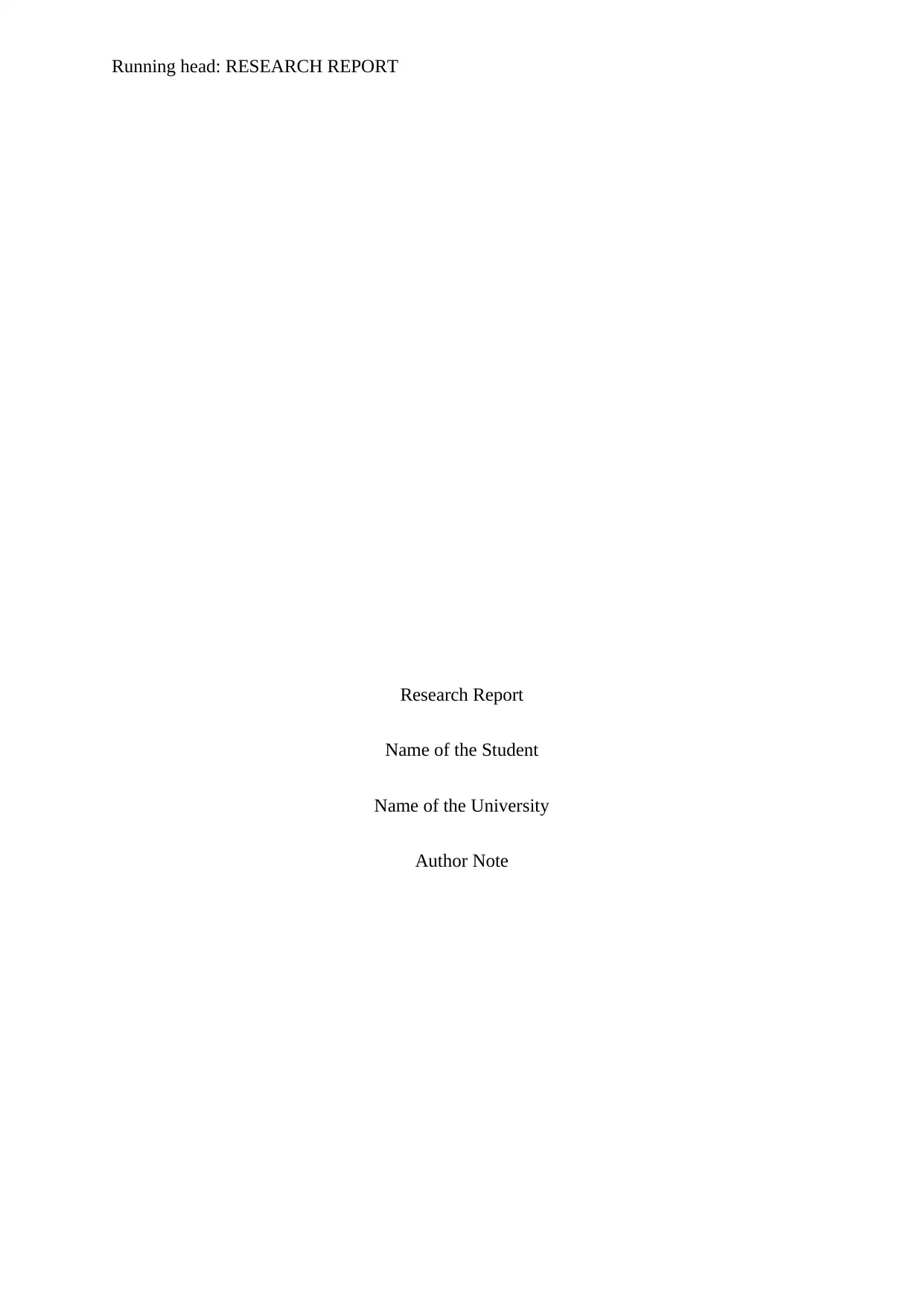
Running head: RESEARCH REPORT
Research Report
Name of the Student
Name of the University
Author Note
Research Report
Name of the Student
Name of the University
Author Note
Paraphrase This Document
Need a fresh take? Get an instant paraphrase of this document with our AI Paraphraser
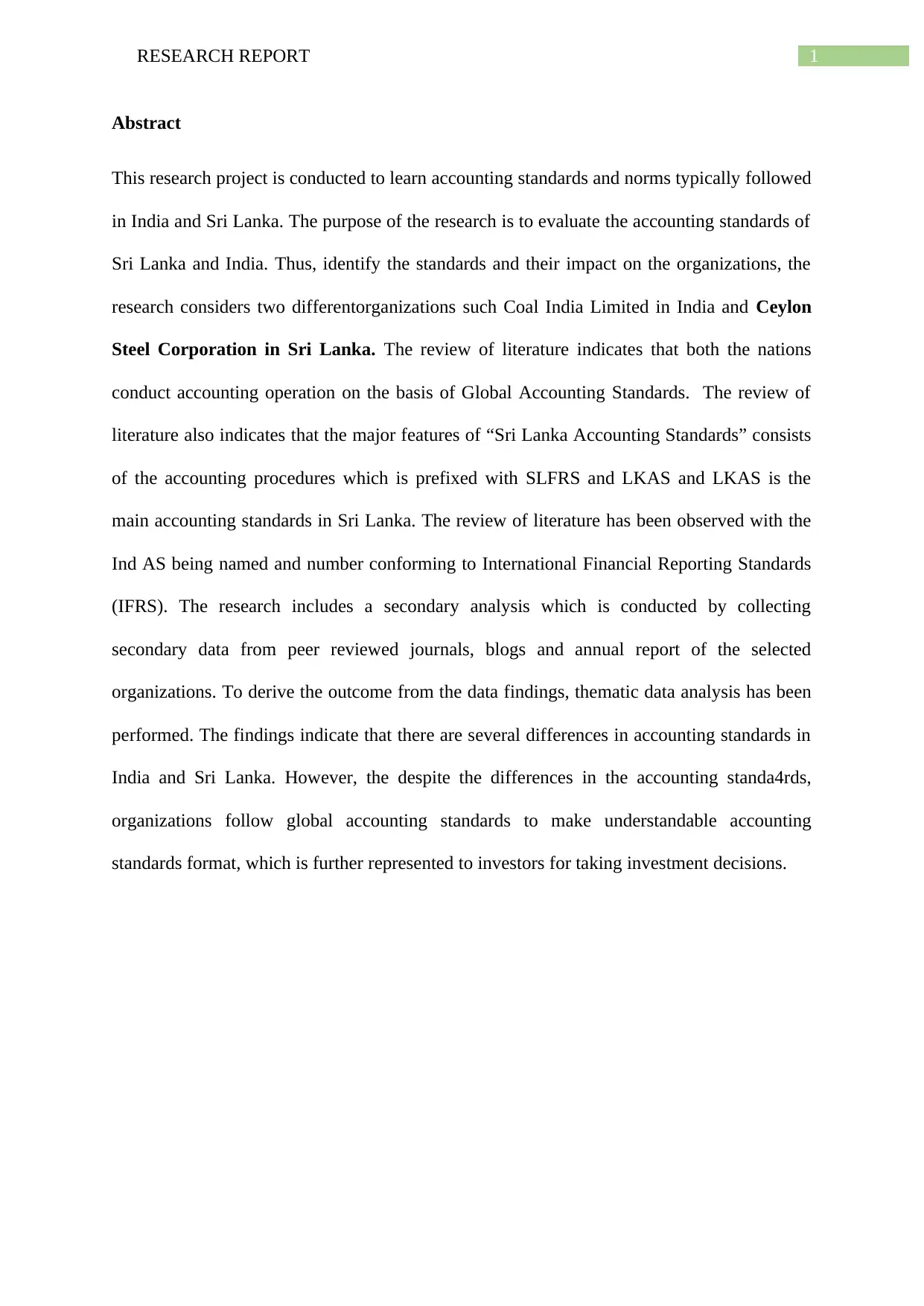
1RESEARCH REPORT
Abstract
This research project is conducted to learn accounting standards and norms typically followed
in India and Sri Lanka. The purpose of the research is to evaluate the accounting standards of
Sri Lanka and India. Thus, identify the standards and their impact on the organizations, the
research considers two differentorganizations such Coal India Limited in India and Ceylon
Steel Corporation in Sri Lanka. The review of literature indicates that both the nations
conduct accounting operation on the basis of Global Accounting Standards. The review of
literature also indicates that the major features of “Sri Lanka Accounting Standards” consists
of the accounting procedures which is prefixed with SLFRS and LKAS and LKAS is the
main accounting standards in Sri Lanka. The review of literature has been observed with the
Ind AS being named and number conforming to International Financial Reporting Standards
(IFRS). The research includes a secondary analysis which is conducted by collecting
secondary data from peer reviewed journals, blogs and annual report of the selected
organizations. To derive the outcome from the data findings, thematic data analysis has been
performed. The findings indicate that there are several differences in accounting standards in
India and Sri Lanka. However, the despite the differences in the accounting standa4rds,
organizations follow global accounting standards to make understandable accounting
standards format, which is further represented to investors for taking investment decisions.
Abstract
This research project is conducted to learn accounting standards and norms typically followed
in India and Sri Lanka. The purpose of the research is to evaluate the accounting standards of
Sri Lanka and India. Thus, identify the standards and their impact on the organizations, the
research considers two differentorganizations such Coal India Limited in India and Ceylon
Steel Corporation in Sri Lanka. The review of literature indicates that both the nations
conduct accounting operation on the basis of Global Accounting Standards. The review of
literature also indicates that the major features of “Sri Lanka Accounting Standards” consists
of the accounting procedures which is prefixed with SLFRS and LKAS and LKAS is the
main accounting standards in Sri Lanka. The review of literature has been observed with the
Ind AS being named and number conforming to International Financial Reporting Standards
(IFRS). The research includes a secondary analysis which is conducted by collecting
secondary data from peer reviewed journals, blogs and annual report of the selected
organizations. To derive the outcome from the data findings, thematic data analysis has been
performed. The findings indicate that there are several differences in accounting standards in
India and Sri Lanka. However, the despite the differences in the accounting standa4rds,
organizations follow global accounting standards to make understandable accounting
standards format, which is further represented to investors for taking investment decisions.
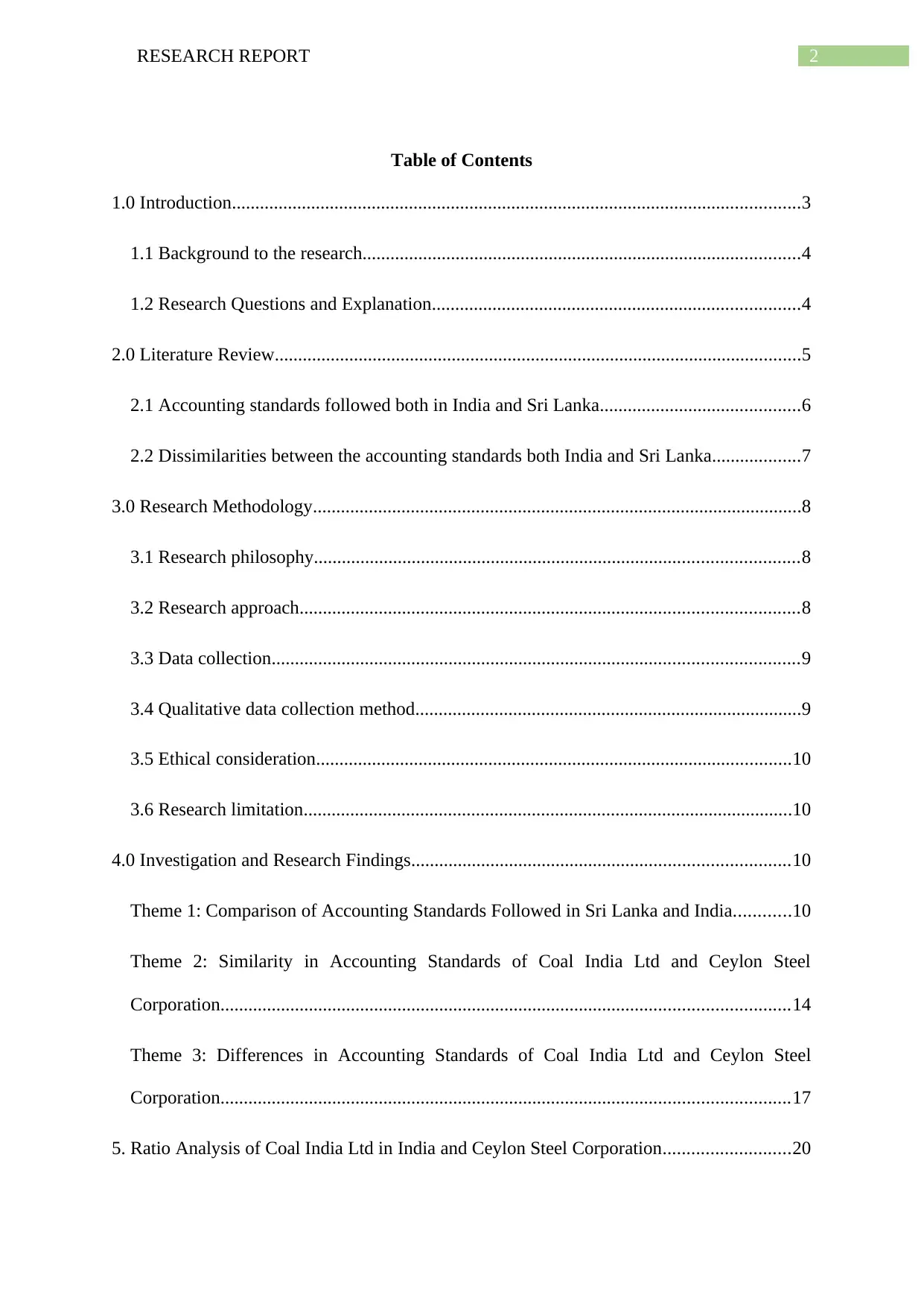
2RESEARCH REPORT
Table of Contents
1.0 Introduction..........................................................................................................................3
1.1 Background to the research..............................................................................................4
1.2 Research Questions and Explanation...............................................................................4
2.0 Literature Review.................................................................................................................5
2.1 Accounting standards followed both in India and Sri Lanka...........................................6
2.2 Dissimilarities between the accounting standards both India and Sri Lanka...................7
3.0 Research Methodology.........................................................................................................8
3.1 Research philosophy........................................................................................................8
3.2 Research approach...........................................................................................................8
3.3 Data collection.................................................................................................................9
3.4 Qualitative data collection method...................................................................................9
3.5 Ethical consideration......................................................................................................10
3.6 Research limitation.........................................................................................................10
4.0 Investigation and Research Findings.................................................................................10
Theme 1: Comparison of Accounting Standards Followed in Sri Lanka and India............10
Theme 2: Similarity in Accounting Standards of Coal India Ltd and Ceylon Steel
Corporation..........................................................................................................................14
Theme 3: Differences in Accounting Standards of Coal India Ltd and Ceylon Steel
Corporation..........................................................................................................................17
5. Ratio Analysis of Coal India Ltd in India and Ceylon Steel Corporation...........................20
Table of Contents
1.0 Introduction..........................................................................................................................3
1.1 Background to the research..............................................................................................4
1.2 Research Questions and Explanation...............................................................................4
2.0 Literature Review.................................................................................................................5
2.1 Accounting standards followed both in India and Sri Lanka...........................................6
2.2 Dissimilarities between the accounting standards both India and Sri Lanka...................7
3.0 Research Methodology.........................................................................................................8
3.1 Research philosophy........................................................................................................8
3.2 Research approach...........................................................................................................8
3.3 Data collection.................................................................................................................9
3.4 Qualitative data collection method...................................................................................9
3.5 Ethical consideration......................................................................................................10
3.6 Research limitation.........................................................................................................10
4.0 Investigation and Research Findings.................................................................................10
Theme 1: Comparison of Accounting Standards Followed in Sri Lanka and India............10
Theme 2: Similarity in Accounting Standards of Coal India Ltd and Ceylon Steel
Corporation..........................................................................................................................14
Theme 3: Differences in Accounting Standards of Coal India Ltd and Ceylon Steel
Corporation..........................................................................................................................17
5. Ratio Analysis of Coal India Ltd in India and Ceylon Steel Corporation...........................20
⊘ This is a preview!⊘
Do you want full access?
Subscribe today to unlock all pages.

Trusted by 1+ million students worldwide
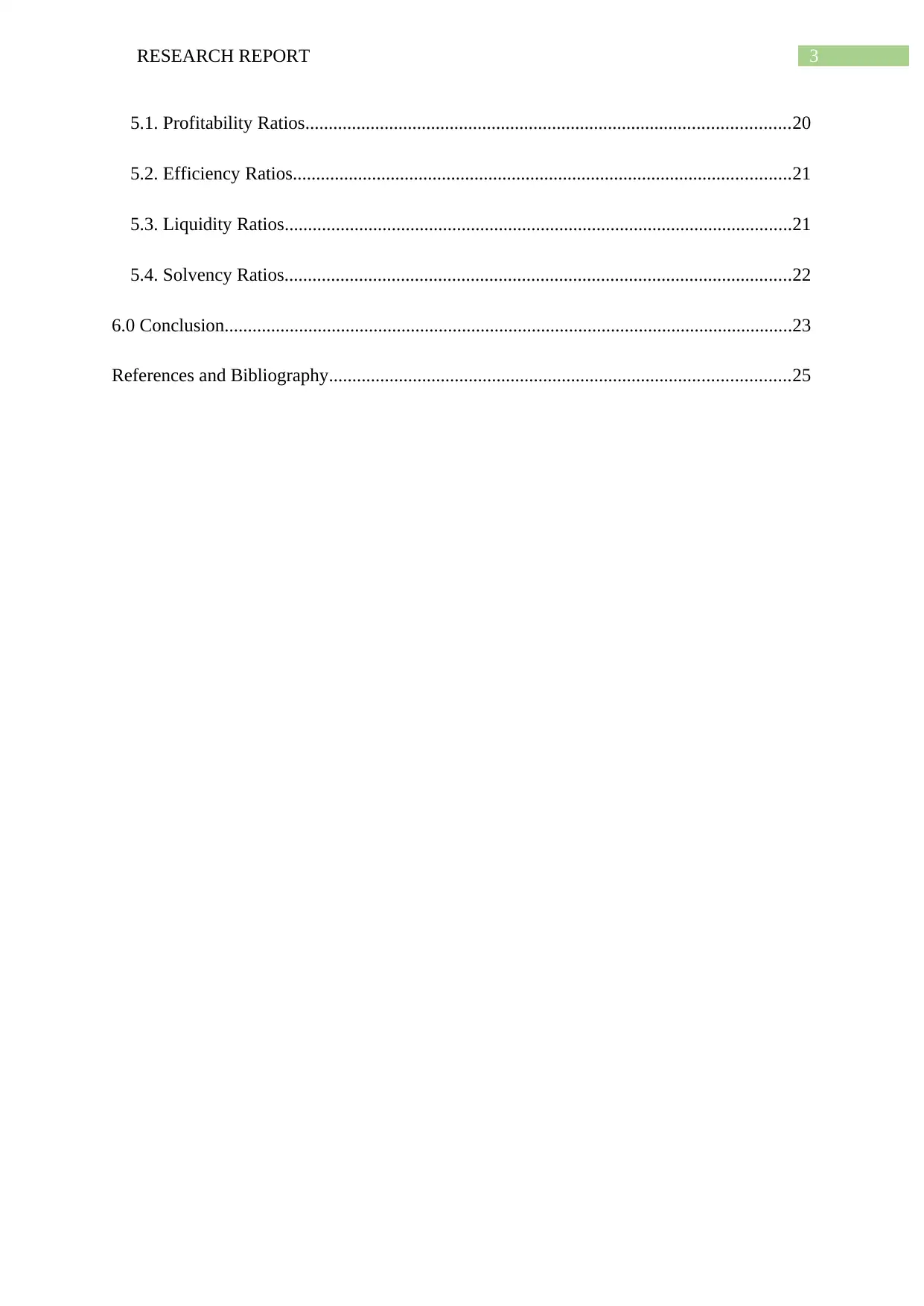
3RESEARCH REPORT
5.1. Profitability Ratios........................................................................................................20
5.2. Efficiency Ratios...........................................................................................................21
5.3. Liquidity Ratios.............................................................................................................21
5.4. Solvency Ratios.............................................................................................................22
6.0 Conclusion..........................................................................................................................23
References and Bibliography...................................................................................................25
5.1. Profitability Ratios........................................................................................................20
5.2. Efficiency Ratios...........................................................................................................21
5.3. Liquidity Ratios.............................................................................................................21
5.4. Solvency Ratios.............................................................................................................22
6.0 Conclusion..........................................................................................................................23
References and Bibliography...................................................................................................25
Paraphrase This Document
Need a fresh take? Get an instant paraphrase of this document with our AI Paraphraser
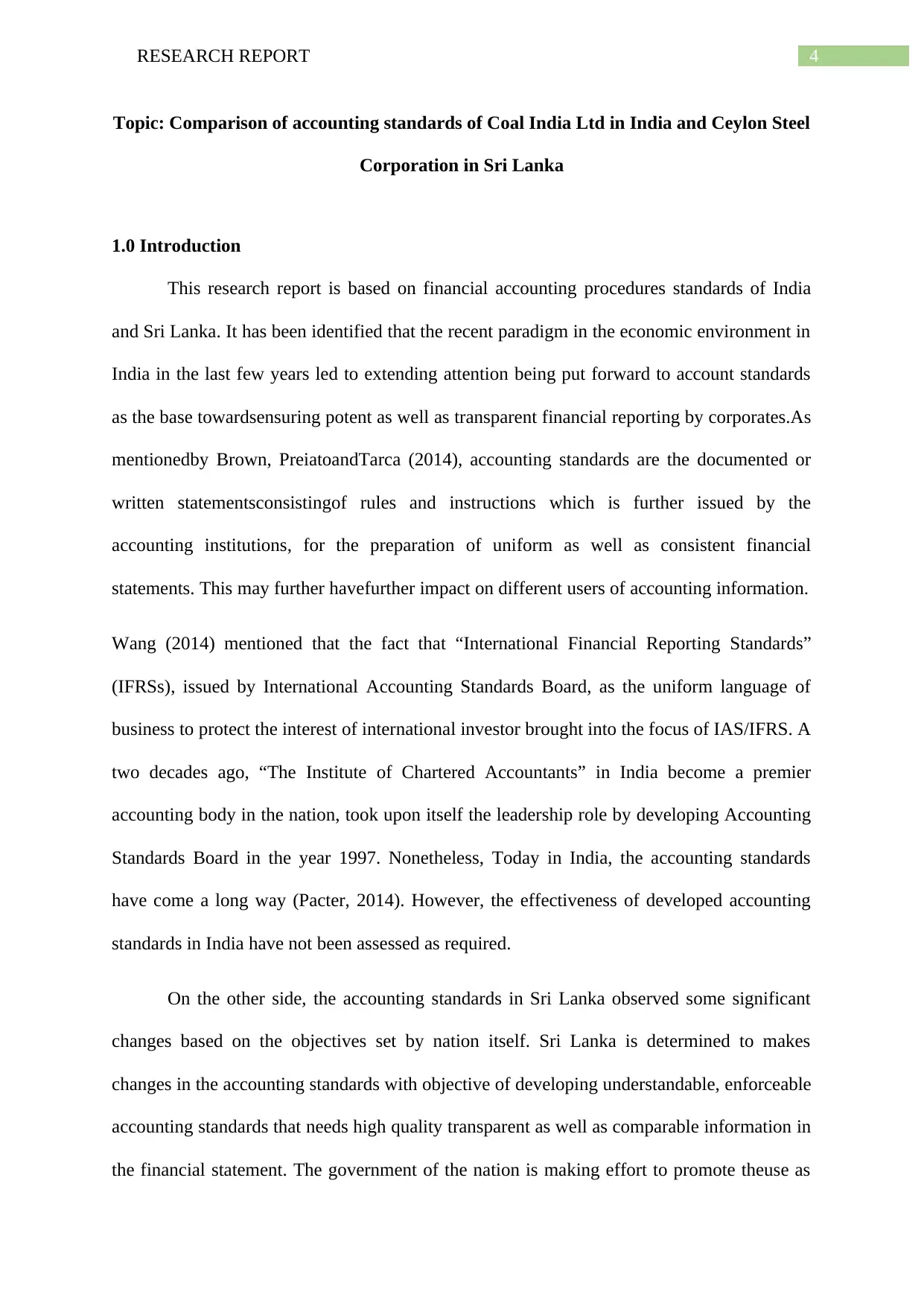
4RESEARCH REPORT
Topic: Comparison of accounting standards of Coal India Ltd in India and Ceylon Steel
Corporation in Sri Lanka
1.0 Introduction
This research report is based on financial accounting procedures standards of India
and Sri Lanka. It has been identified that the recent paradigm in the economic environment in
India in the last few years led to extending attention being put forward to account standards
as the base towardsensuring potent as well as transparent financial reporting by corporates.As
mentionedby Brown, PreiatoandTarca (2014), accounting standards are the documented or
written statementsconsistingof rules and instructions which is further issued by the
accounting institutions, for the preparation of uniform as well as consistent financial
statements. This may further havefurther impact on different users of accounting information.
Wang (2014) mentioned that the fact that “International Financial Reporting Standards”
(IFRSs), issued by International Accounting Standards Board, as the uniform language of
business to protect the interest of international investor brought into the focus of IAS/IFRS. A
two decades ago, “The Institute of Chartered Accountants” in India become a premier
accounting body in the nation, took upon itself the leadership role by developing Accounting
Standards Board in the year 1997. Nonetheless, Today in India, the accounting standards
have come a long way (Pacter, 2014). However, the effectiveness of developed accounting
standards in India have not been assessed as required.
On the other side, the accounting standards in Sri Lanka observed some significant
changes based on the objectives set by nation itself. Sri Lanka is determined to makes
changes in the accounting standards with objective of developing understandable, enforceable
accounting standards that needs high quality transparent as well as comparable information in
the financial statement. The government of the nation is making effort to promote theuse as
Topic: Comparison of accounting standards of Coal India Ltd in India and Ceylon Steel
Corporation in Sri Lanka
1.0 Introduction
This research report is based on financial accounting procedures standards of India
and Sri Lanka. It has been identified that the recent paradigm in the economic environment in
India in the last few years led to extending attention being put forward to account standards
as the base towardsensuring potent as well as transparent financial reporting by corporates.As
mentionedby Brown, PreiatoandTarca (2014), accounting standards are the documented or
written statementsconsistingof rules and instructions which is further issued by the
accounting institutions, for the preparation of uniform as well as consistent financial
statements. This may further havefurther impact on different users of accounting information.
Wang (2014) mentioned that the fact that “International Financial Reporting Standards”
(IFRSs), issued by International Accounting Standards Board, as the uniform language of
business to protect the interest of international investor brought into the focus of IAS/IFRS. A
two decades ago, “The Institute of Chartered Accountants” in India become a premier
accounting body in the nation, took upon itself the leadership role by developing Accounting
Standards Board in the year 1997. Nonetheless, Today in India, the accounting standards
have come a long way (Pacter, 2014). However, the effectiveness of developed accounting
standards in India have not been assessed as required.
On the other side, the accounting standards in Sri Lanka observed some significant
changes based on the objectives set by nation itself. Sri Lanka is determined to makes
changes in the accounting standards with objective of developing understandable, enforceable
accounting standards that needs high quality transparent as well as comparable information in
the financial statement. The government of the nation is making effort to promote theuse as
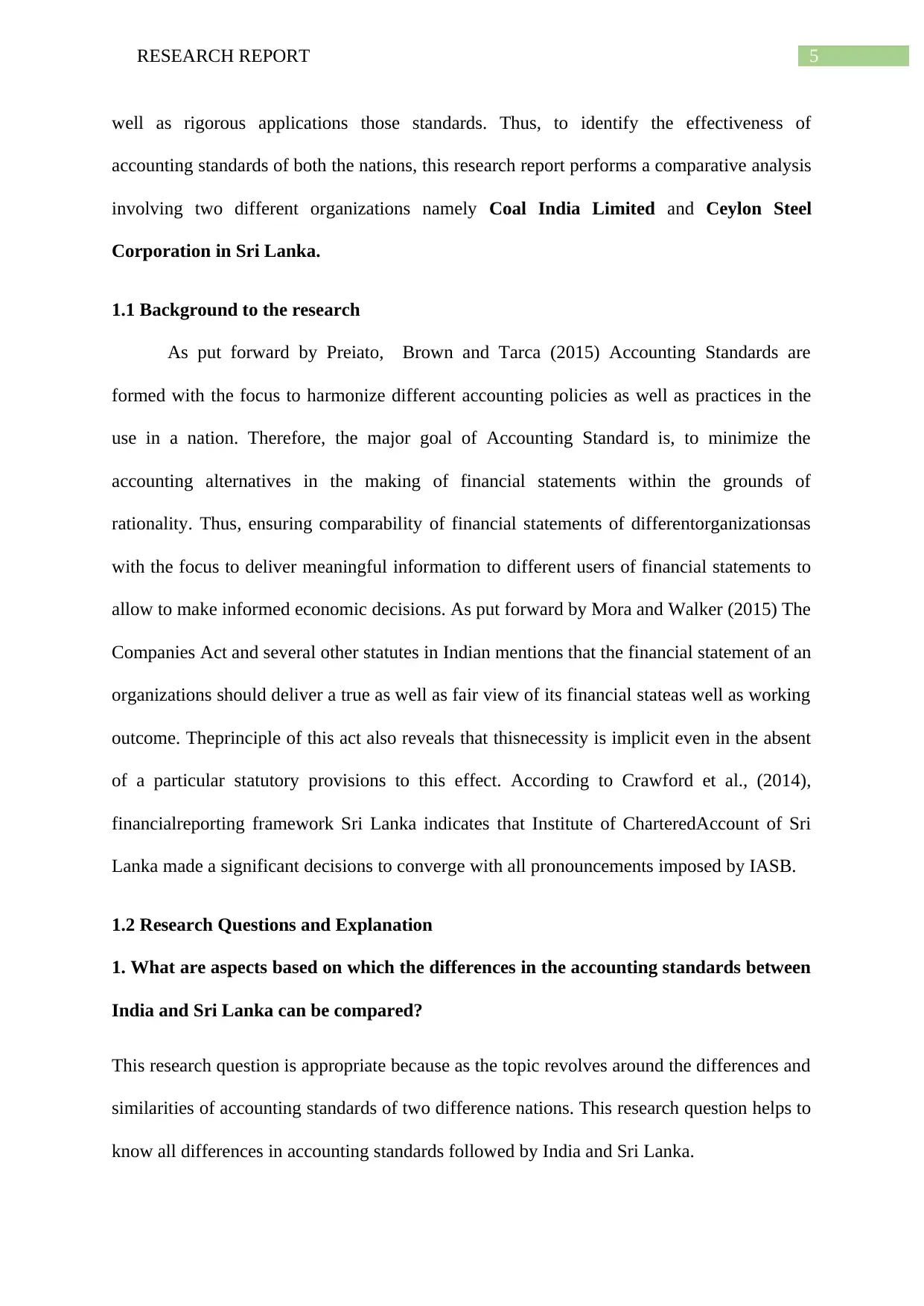
5RESEARCH REPORT
well as rigorous applications those standards. Thus, to identify the effectiveness of
accounting standards of both the nations, this research report performs a comparative analysis
involving two different organizations namely Coal India Limited and Ceylon Steel
Corporation in Sri Lanka.
1.1 Background to the research
As put forward by Preiato, Brown and Tarca (2015) Accounting Standards are
formed with the focus to harmonize different accounting policies as well as practices in the
use in a nation. Therefore, the major goal of Accounting Standard is, to minimize the
accounting alternatives in the making of financial statements within the grounds of
rationality. Thus, ensuring comparability of financial statements of differentorganizationsas
with the focus to deliver meaningful information to different users of financial statements to
allow to make informed economic decisions. As put forward by Mora and Walker (2015) The
Companies Act and several other statutes in Indian mentions that the financial statement of an
organizations should deliver a true as well as fair view of its financial stateas well as working
outcome. Theprinciple of this act also reveals that thisnecessity is implicit even in the absent
of a particular statutory provisions to this effect. According to Crawford et al., (2014),
financialreporting framework Sri Lanka indicates that Institute of CharteredAccount of Sri
Lanka made a significant decisions to converge with all pronouncements imposed by IASB.
1.2 Research Questions and Explanation
1. What are aspects based on which the differences in the accounting standards between
India and Sri Lanka can be compared?
This research question is appropriate because as the topic revolves around the differences and
similarities of accounting standards of two difference nations. This research question helps to
know all differences in accounting standards followed by India and Sri Lanka.
well as rigorous applications those standards. Thus, to identify the effectiveness of
accounting standards of both the nations, this research report performs a comparative analysis
involving two different organizations namely Coal India Limited and Ceylon Steel
Corporation in Sri Lanka.
1.1 Background to the research
As put forward by Preiato, Brown and Tarca (2015) Accounting Standards are
formed with the focus to harmonize different accounting policies as well as practices in the
use in a nation. Therefore, the major goal of Accounting Standard is, to minimize the
accounting alternatives in the making of financial statements within the grounds of
rationality. Thus, ensuring comparability of financial statements of differentorganizationsas
with the focus to deliver meaningful information to different users of financial statements to
allow to make informed economic decisions. As put forward by Mora and Walker (2015) The
Companies Act and several other statutes in Indian mentions that the financial statement of an
organizations should deliver a true as well as fair view of its financial stateas well as working
outcome. Theprinciple of this act also reveals that thisnecessity is implicit even in the absent
of a particular statutory provisions to this effect. According to Crawford et al., (2014),
financialreporting framework Sri Lanka indicates that Institute of CharteredAccount of Sri
Lanka made a significant decisions to converge with all pronouncements imposed by IASB.
1.2 Research Questions and Explanation
1. What are aspects based on which the differences in the accounting standards between
India and Sri Lanka can be compared?
This research question is appropriate because as the topic revolves around the differences and
similarities of accounting standards of two difference nations. This research question helps to
know all differences in accounting standards followed by India and Sri Lanka.
⊘ This is a preview!⊘
Do you want full access?
Subscribe today to unlock all pages.

Trusted by 1+ million students worldwide
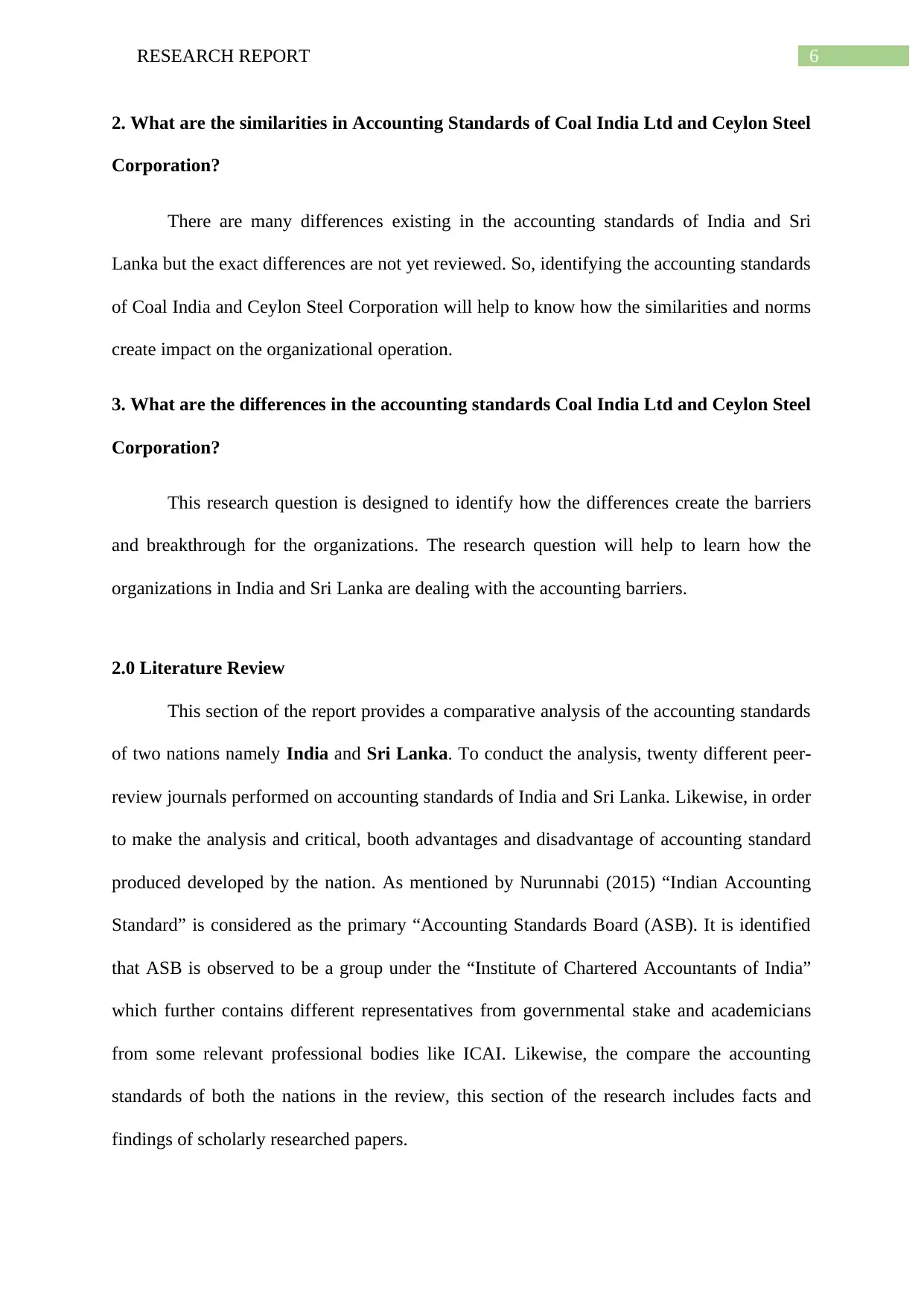
6RESEARCH REPORT
2. What are the similarities in Accounting Standards of Coal India Ltd and Ceylon Steel
Corporation?
There are many differences existing in the accounting standards of India and Sri
Lanka but the exact differences are not yet reviewed. So, identifying the accounting standards
of Coal India and Ceylon Steel Corporation will help to know how the similarities and norms
create impact on the organizational operation.
3. What are the differences in the accounting standards Coal India Ltd and Ceylon Steel
Corporation?
This research question is designed to identify how the differences create the barriers
and breakthrough for the organizations. The research question will help to learn how the
organizations in India and Sri Lanka are dealing with the accounting barriers.
2.0 Literature Review
This section of the report provides a comparative analysis of the accounting standards
of two nations namely India and Sri Lanka. To conduct the analysis, twenty different peer-
review journals performed on accounting standards of India and Sri Lanka. Likewise, in order
to make the analysis and critical, booth advantages and disadvantage of accounting standard
produced developed by the nation. As mentioned by Nurunnabi (2015) “Indian Accounting
Standard” is considered as the primary “Accounting Standards Board (ASB). It is identified
that ASB is observed to be a group under the “Institute of Chartered Accountants of India”
which further contains different representatives from governmental stake and academicians
from some relevant professional bodies like ICAI. Likewise, the compare the accounting
standards of both the nations in the review, this section of the research includes facts and
findings of scholarly researched papers.
2. What are the similarities in Accounting Standards of Coal India Ltd and Ceylon Steel
Corporation?
There are many differences existing in the accounting standards of India and Sri
Lanka but the exact differences are not yet reviewed. So, identifying the accounting standards
of Coal India and Ceylon Steel Corporation will help to know how the similarities and norms
create impact on the organizational operation.
3. What are the differences in the accounting standards Coal India Ltd and Ceylon Steel
Corporation?
This research question is designed to identify how the differences create the barriers
and breakthrough for the organizations. The research question will help to learn how the
organizations in India and Sri Lanka are dealing with the accounting barriers.
2.0 Literature Review
This section of the report provides a comparative analysis of the accounting standards
of two nations namely India and Sri Lanka. To conduct the analysis, twenty different peer-
review journals performed on accounting standards of India and Sri Lanka. Likewise, in order
to make the analysis and critical, booth advantages and disadvantage of accounting standard
produced developed by the nation. As mentioned by Nurunnabi (2015) “Indian Accounting
Standard” is considered as the primary “Accounting Standards Board (ASB). It is identified
that ASB is observed to be a group under the “Institute of Chartered Accountants of India”
which further contains different representatives from governmental stake and academicians
from some relevant professional bodies like ICAI. Likewise, the compare the accounting
standards of both the nations in the review, this section of the research includes facts and
findings of scholarly researched papers.
Paraphrase This Document
Need a fresh take? Get an instant paraphrase of this document with our AI Paraphraser
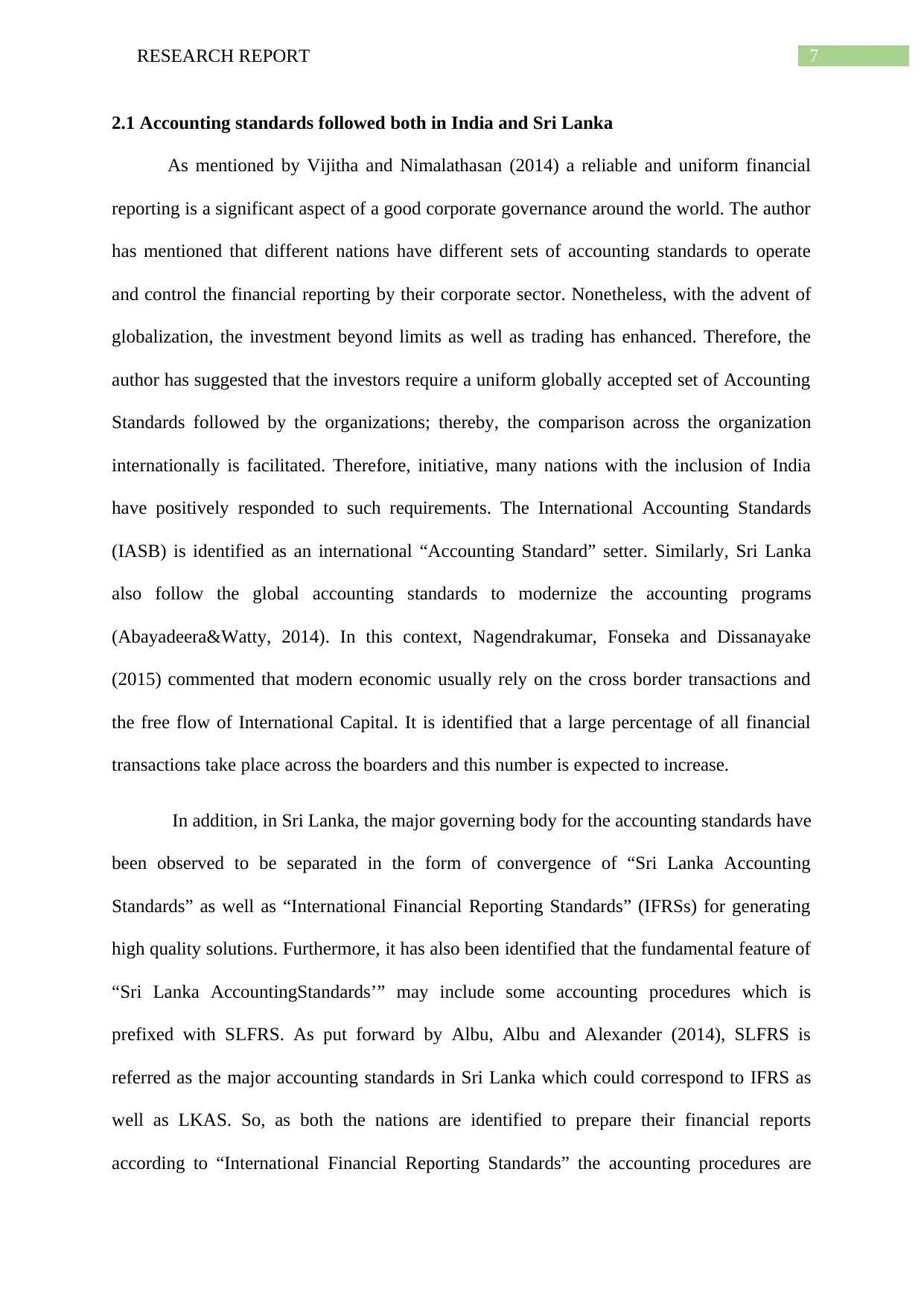
7RESEARCH REPORT
2.1 Accounting standards followed both in India and Sri Lanka
As mentioned by Vijitha and Nimalathasan (2014) a reliable and uniform financial
reporting is a significant aspect of a good corporate governance around the world. The author
has mentioned that different nations have different sets of accounting standards to operate
and control the financial reporting by their corporate sector. Nonetheless, with the advent of
globalization, the investment beyond limits as well as trading has enhanced. Therefore, the
author has suggested that the investors require a uniform globally accepted set of Accounting
Standards followed by the organizations; thereby, the comparison across the organization
internationally is facilitated. Therefore, initiative, many nations with the inclusion of India
have positively responded to such requirements. The International Accounting Standards
(IASB) is identified as an international “Accounting Standard” setter. Similarly, Sri Lanka
also follow the global accounting standards to modernize the accounting programs
(Abayadeera&Watty, 2014). In this context, Nagendrakumar, Fonseka and Dissanayake
(2015) commented that modern economic usually rely on the cross border transactions and
the free flow of International Capital. It is identified that a large percentage of all financial
transactions take place across the boarders and this number is expected to increase.
In addition, in Sri Lanka, the major governing body for the accounting standards have
been observed to be separated in the form of convergence of “Sri Lanka Accounting
Standards” as well as “International Financial Reporting Standards” (IFRSs) for generating
high quality solutions. Furthermore, it has also been identified that the fundamental feature of
“Sri Lanka AccountingStandards’” may include some accounting procedures which is
prefixed with SLFRS. As put forward by Albu, Albu and Alexander (2014), SLFRS is
referred as the major accounting standards in Sri Lanka which could correspond to IFRS as
well as LKAS. So, as both the nations are identified to prepare their financial reports
according to “International Financial Reporting Standards” the accounting procedures are
2.1 Accounting standards followed both in India and Sri Lanka
As mentioned by Vijitha and Nimalathasan (2014) a reliable and uniform financial
reporting is a significant aspect of a good corporate governance around the world. The author
has mentioned that different nations have different sets of accounting standards to operate
and control the financial reporting by their corporate sector. Nonetheless, with the advent of
globalization, the investment beyond limits as well as trading has enhanced. Therefore, the
author has suggested that the investors require a uniform globally accepted set of Accounting
Standards followed by the organizations; thereby, the comparison across the organization
internationally is facilitated. Therefore, initiative, many nations with the inclusion of India
have positively responded to such requirements. The International Accounting Standards
(IASB) is identified as an international “Accounting Standard” setter. Similarly, Sri Lanka
also follow the global accounting standards to modernize the accounting programs
(Abayadeera&Watty, 2014). In this context, Nagendrakumar, Fonseka and Dissanayake
(2015) commented that modern economic usually rely on the cross border transactions and
the free flow of International Capital. It is identified that a large percentage of all financial
transactions take place across the boarders and this number is expected to increase.
In addition, in Sri Lanka, the major governing body for the accounting standards have
been observed to be separated in the form of convergence of “Sri Lanka Accounting
Standards” as well as “International Financial Reporting Standards” (IFRSs) for generating
high quality solutions. Furthermore, it has also been identified that the fundamental feature of
“Sri Lanka AccountingStandards’” may include some accounting procedures which is
prefixed with SLFRS. As put forward by Albu, Albu and Alexander (2014), SLFRS is
referred as the major accounting standards in Sri Lanka which could correspond to IFRS as
well as LKAS. So, as both the nations are identified to prepare their financial reports
according to “International Financial Reporting Standards” the accounting procedures are
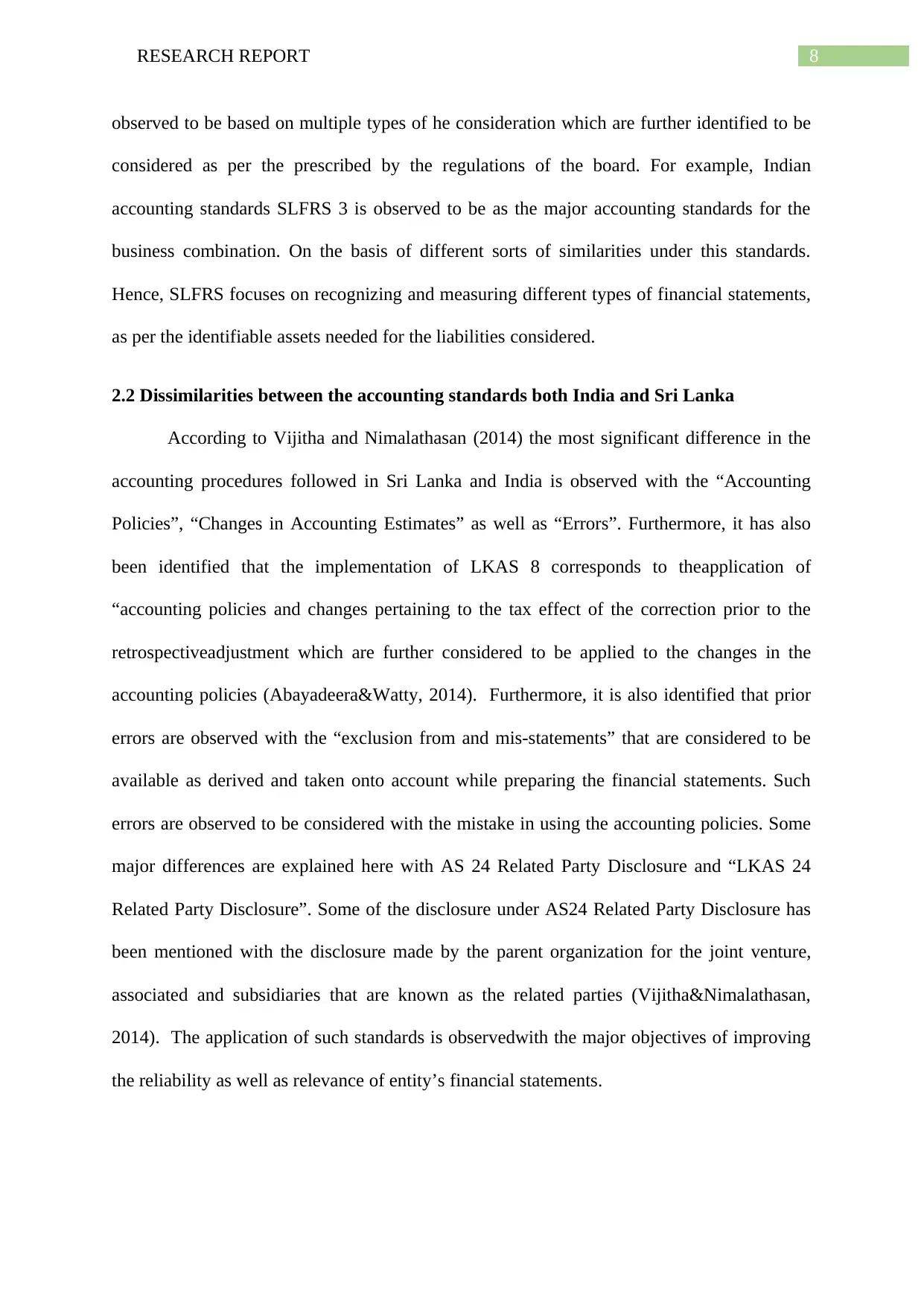
8RESEARCH REPORT
observed to be based on multiple types of he consideration which are further identified to be
considered as per the prescribed by the regulations of the board. For example, Indian
accounting standards SLFRS 3 is observed to be as the major accounting standards for the
business combination. On the basis of different sorts of similarities under this standards.
Hence, SLFRS focuses on recognizing and measuring different types of financial statements,
as per the identifiable assets needed for the liabilities considered.
2.2 Dissimilarities between the accounting standards both India and Sri Lanka
According to Vijitha and Nimalathasan (2014) the most significant difference in the
accounting procedures followed in Sri Lanka and India is observed with the “Accounting
Policies”, “Changes in Accounting Estimates” as well as “Errors”. Furthermore, it has also
been identified that the implementation of LKAS 8 corresponds to theapplication of
“accounting policies and changes pertaining to the tax effect of the correction prior to the
retrospectiveadjustment which are further considered to be applied to the changes in the
accounting policies (Abayadeera&Watty, 2014). Furthermore, it is also identified that prior
errors are observed with the “exclusion from and mis-statements” that are considered to be
available as derived and taken onto account while preparing the financial statements. Such
errors are observed to be considered with the mistake in using the accounting policies. Some
major differences are explained here with AS 24 Related Party Disclosure and “LKAS 24
Related Party Disclosure”. Some of the disclosure under AS24 Related Party Disclosure has
been mentioned with the disclosure made by the parent organization for the joint venture,
associated and subsidiaries that are known as the related parties (Vijitha&Nimalathasan,
2014). The application of such standards is observedwith the major objectives of improving
the reliability as well as relevance of entity’s financial statements.
observed to be based on multiple types of he consideration which are further identified to be
considered as per the prescribed by the regulations of the board. For example, Indian
accounting standards SLFRS 3 is observed to be as the major accounting standards for the
business combination. On the basis of different sorts of similarities under this standards.
Hence, SLFRS focuses on recognizing and measuring different types of financial statements,
as per the identifiable assets needed for the liabilities considered.
2.2 Dissimilarities between the accounting standards both India and Sri Lanka
According to Vijitha and Nimalathasan (2014) the most significant difference in the
accounting procedures followed in Sri Lanka and India is observed with the “Accounting
Policies”, “Changes in Accounting Estimates” as well as “Errors”. Furthermore, it has also
been identified that the implementation of LKAS 8 corresponds to theapplication of
“accounting policies and changes pertaining to the tax effect of the correction prior to the
retrospectiveadjustment which are further considered to be applied to the changes in the
accounting policies (Abayadeera&Watty, 2014). Furthermore, it is also identified that prior
errors are observed with the “exclusion from and mis-statements” that are considered to be
available as derived and taken onto account while preparing the financial statements. Such
errors are observed to be considered with the mistake in using the accounting policies. Some
major differences are explained here with AS 24 Related Party Disclosure and “LKAS 24
Related Party Disclosure”. Some of the disclosure under AS24 Related Party Disclosure has
been mentioned with the disclosure made by the parent organization for the joint venture,
associated and subsidiaries that are known as the related parties (Vijitha&Nimalathasan,
2014). The application of such standards is observedwith the major objectives of improving
the reliability as well as relevance of entity’s financial statements.
⊘ This is a preview!⊘
Do you want full access?
Subscribe today to unlock all pages.

Trusted by 1+ million students worldwide
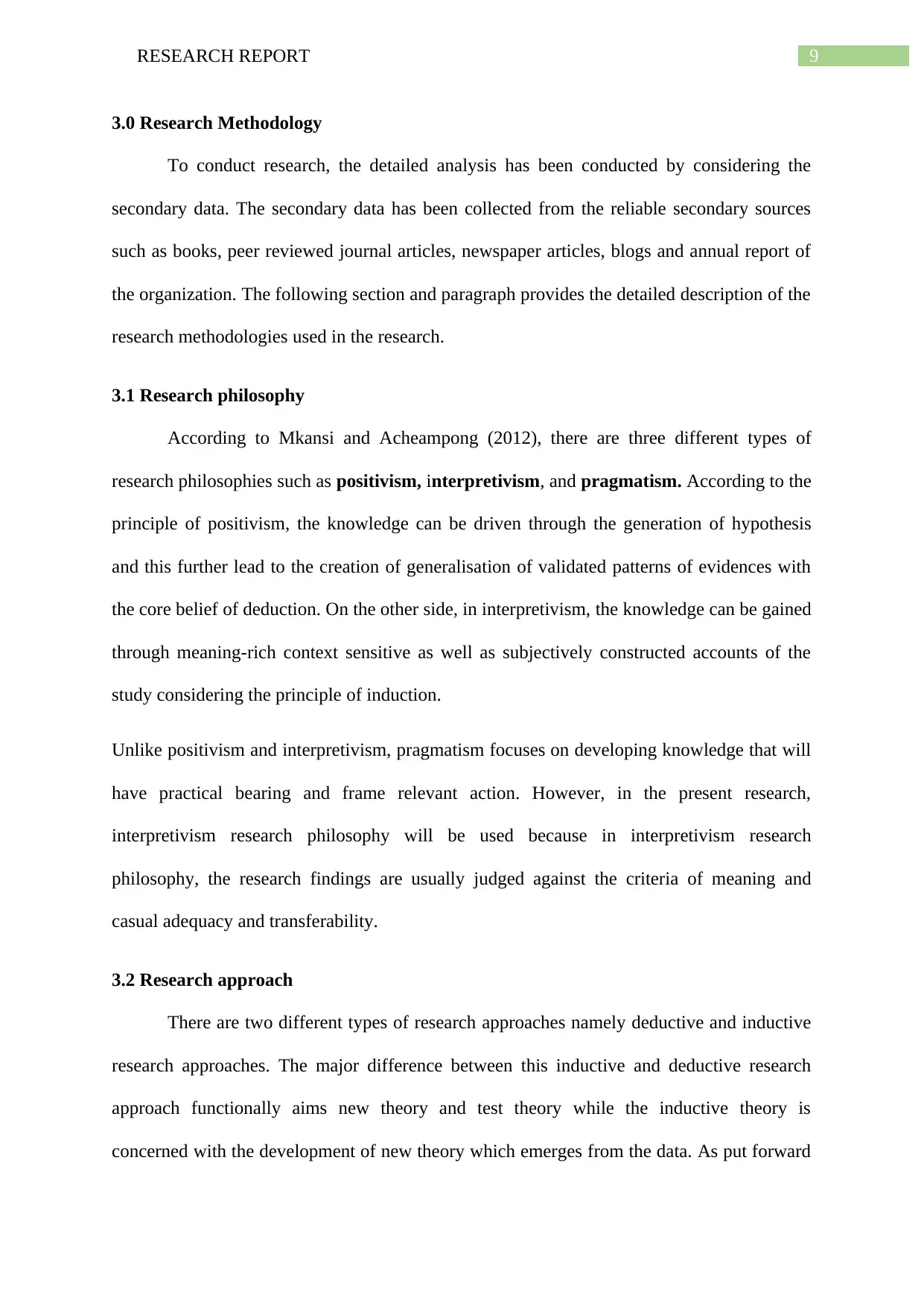
9RESEARCH REPORT
3.0 Research Methodology
To conduct research, the detailed analysis has been conducted by considering the
secondary data. The secondary data has been collected from the reliable secondary sources
such as books, peer reviewed journal articles, newspaper articles, blogs and annual report of
the organization. The following section and paragraph provides the detailed description of the
research methodologies used in the research.
3.1 Research philosophy
According to Mkansi and Acheampong (2012), there are three different types of
research philosophies such as positivism, interpretivism, and pragmatism. According to the
principle of positivism, the knowledge can be driven through the generation of hypothesis
and this further lead to the creation of generalisation of validated patterns of evidences with
the core belief of deduction. On the other side, in interpretivism, the knowledge can be gained
through meaning-rich context sensitive as well as subjectively constructed accounts of the
study considering the principle of induction.
Unlike positivism and interpretivism, pragmatism focuses on developing knowledge that will
have practical bearing and frame relevant action. However, in the present research,
interpretivism research philosophy will be used because in interpretivism research
philosophy, the research findings are usually judged against the criteria of meaning and
casual adequacy and transferability.
3.2 Research approach
There are two different types of research approaches namely deductive and inductive
research approaches. The major difference between this inductive and deductive research
approach functionally aims new theory and test theory while the inductive theory is
concerned with the development of new theory which emerges from the data. As put forward
3.0 Research Methodology
To conduct research, the detailed analysis has been conducted by considering the
secondary data. The secondary data has been collected from the reliable secondary sources
such as books, peer reviewed journal articles, newspaper articles, blogs and annual report of
the organization. The following section and paragraph provides the detailed description of the
research methodologies used in the research.
3.1 Research philosophy
According to Mkansi and Acheampong (2012), there are three different types of
research philosophies such as positivism, interpretivism, and pragmatism. According to the
principle of positivism, the knowledge can be driven through the generation of hypothesis
and this further lead to the creation of generalisation of validated patterns of evidences with
the core belief of deduction. On the other side, in interpretivism, the knowledge can be gained
through meaning-rich context sensitive as well as subjectively constructed accounts of the
study considering the principle of induction.
Unlike positivism and interpretivism, pragmatism focuses on developing knowledge that will
have practical bearing and frame relevant action. However, in the present research,
interpretivism research philosophy will be used because in interpretivism research
philosophy, the research findings are usually judged against the criteria of meaning and
casual adequacy and transferability.
3.2 Research approach
There are two different types of research approaches namely deductive and inductive
research approaches. The major difference between this inductive and deductive research
approach functionally aims new theory and test theory while the inductive theory is
concerned with the development of new theory which emerges from the data. As put forward
Paraphrase This Document
Need a fresh take? Get an instant paraphrase of this document with our AI Paraphraser
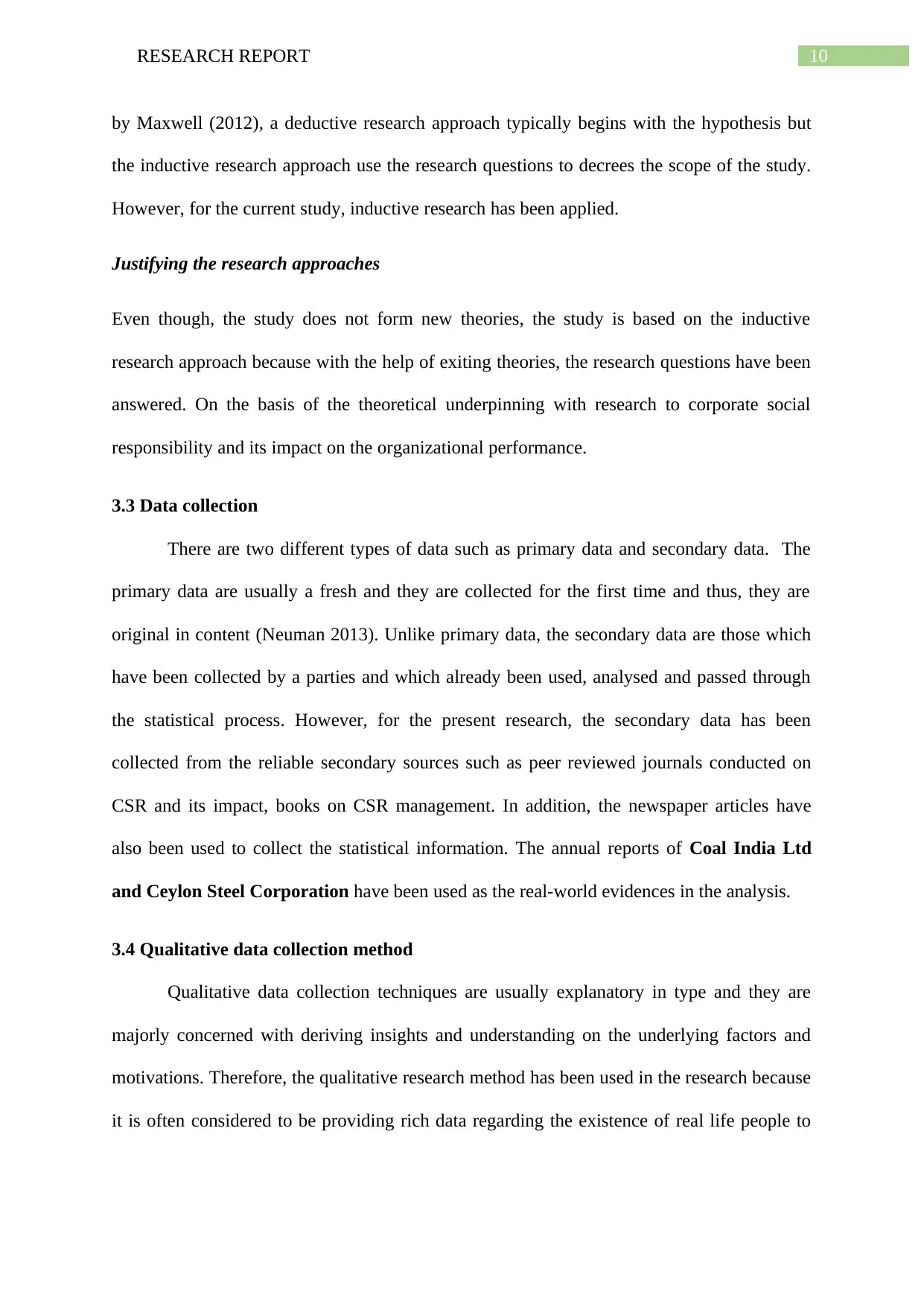
10RESEARCH REPORT
by Maxwell (2012), a deductive research approach typically begins with the hypothesis but
the inductive research approach use the research questions to decrees the scope of the study.
However, for the current study, inductive research has been applied.
Justifying the research approaches
Even though, the study does not form new theories, the study is based on the inductive
research approach because with the help of exiting theories, the research questions have been
answered. On the basis of the theoretical underpinning with research to corporate social
responsibility and its impact on the organizational performance.
3.3 Data collection
There are two different types of data such as primary data and secondary data. The
primary data are usually a fresh and they are collected for the first time and thus, they are
original in content (Neuman 2013). Unlike primary data, the secondary data are those which
have been collected by a parties and which already been used, analysed and passed through
the statistical process. However, for the present research, the secondary data has been
collected from the reliable secondary sources such as peer reviewed journals conducted on
CSR and its impact, books on CSR management. In addition, the newspaper articles have
also been used to collect the statistical information. The annual reports of Coal India Ltd
and Ceylon Steel Corporation have been used as the real-world evidences in the analysis.
3.4 Qualitative data collection method
Qualitative data collection techniques are usually explanatory in type and they are
majorly concerned with deriving insights and understanding on the underlying factors and
motivations. Therefore, the qualitative research method has been used in the research because
it is often considered to be providing rich data regarding the existence of real life people to
by Maxwell (2012), a deductive research approach typically begins with the hypothesis but
the inductive research approach use the research questions to decrees the scope of the study.
However, for the current study, inductive research has been applied.
Justifying the research approaches
Even though, the study does not form new theories, the study is based on the inductive
research approach because with the help of exiting theories, the research questions have been
answered. On the basis of the theoretical underpinning with research to corporate social
responsibility and its impact on the organizational performance.
3.3 Data collection
There are two different types of data such as primary data and secondary data. The
primary data are usually a fresh and they are collected for the first time and thus, they are
original in content (Neuman 2013). Unlike primary data, the secondary data are those which
have been collected by a parties and which already been used, analysed and passed through
the statistical process. However, for the present research, the secondary data has been
collected from the reliable secondary sources such as peer reviewed journals conducted on
CSR and its impact, books on CSR management. In addition, the newspaper articles have
also been used to collect the statistical information. The annual reports of Coal India Ltd
and Ceylon Steel Corporation have been used as the real-world evidences in the analysis.
3.4 Qualitative data collection method
Qualitative data collection techniques are usually explanatory in type and they are
majorly concerned with deriving insights and understanding on the underlying factors and
motivations. Therefore, the qualitative research method has been used in the research because
it is often considered to be providing rich data regarding the existence of real life people to
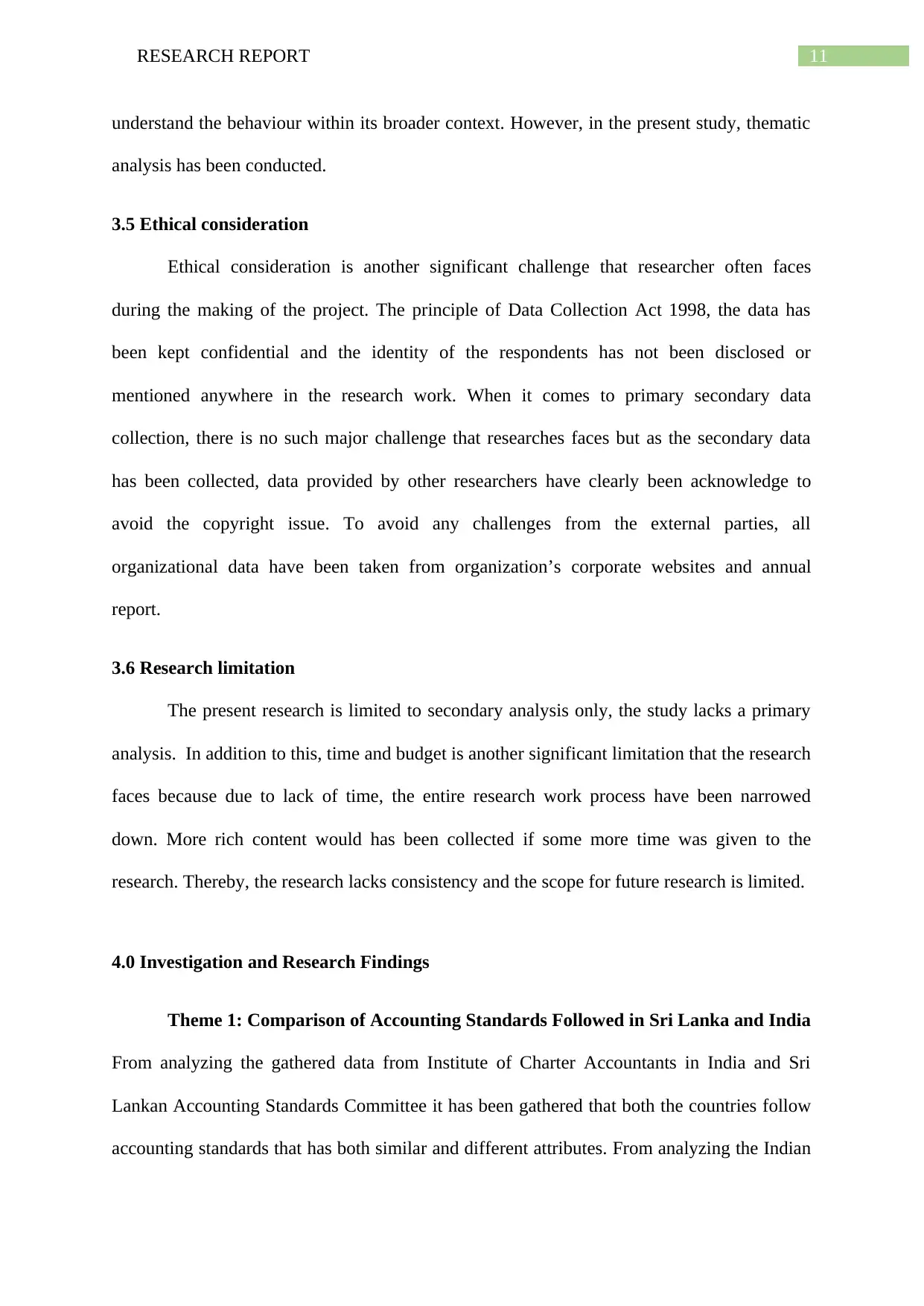
11RESEARCH REPORT
understand the behaviour within its broader context. However, in the present study, thematic
analysis has been conducted.
3.5 Ethical consideration
Ethical consideration is another significant challenge that researcher often faces
during the making of the project. The principle of Data Collection Act 1998, the data has
been kept confidential and the identity of the respondents has not been disclosed or
mentioned anywhere in the research work. When it comes to primary secondary data
collection, there is no such major challenge that researches faces but as the secondary data
has been collected, data provided by other researchers have clearly been acknowledge to
avoid the copyright issue. To avoid any challenges from the external parties, all
organizational data have been taken from organization’s corporate websites and annual
report.
3.6 Research limitation
The present research is limited to secondary analysis only, the study lacks a primary
analysis. In addition to this, time and budget is another significant limitation that the research
faces because due to lack of time, the entire research work process have been narrowed
down. More rich content would has been collected if some more time was given to the
research. Thereby, the research lacks consistency and the scope for future research is limited.
4.0 Investigation and Research Findings
Theme 1: Comparison of Accounting Standards Followed in Sri Lanka and India
From analyzing the gathered data from Institute of Charter Accountants in India and Sri
Lankan Accounting Standards Committee it has been gathered that both the countries follow
accounting standards that has both similar and different attributes. From analyzing the Indian
understand the behaviour within its broader context. However, in the present study, thematic
analysis has been conducted.
3.5 Ethical consideration
Ethical consideration is another significant challenge that researcher often faces
during the making of the project. The principle of Data Collection Act 1998, the data has
been kept confidential and the identity of the respondents has not been disclosed or
mentioned anywhere in the research work. When it comes to primary secondary data
collection, there is no such major challenge that researches faces but as the secondary data
has been collected, data provided by other researchers have clearly been acknowledge to
avoid the copyright issue. To avoid any challenges from the external parties, all
organizational data have been taken from organization’s corporate websites and annual
report.
3.6 Research limitation
The present research is limited to secondary analysis only, the study lacks a primary
analysis. In addition to this, time and budget is another significant limitation that the research
faces because due to lack of time, the entire research work process have been narrowed
down. More rich content would has been collected if some more time was given to the
research. Thereby, the research lacks consistency and the scope for future research is limited.
4.0 Investigation and Research Findings
Theme 1: Comparison of Accounting Standards Followed in Sri Lanka and India
From analyzing the gathered data from Institute of Charter Accountants in India and Sri
Lankan Accounting Standards Committee it has been gathered that both the countries follow
accounting standards that has both similar and different attributes. From analyzing the Indian
⊘ This is a preview!⊘
Do you want full access?
Subscribe today to unlock all pages.

Trusted by 1+ million students worldwide
1 out of 31
Related Documents
Your All-in-One AI-Powered Toolkit for Academic Success.
+13062052269
info@desklib.com
Available 24*7 on WhatsApp / Email
![[object Object]](/_next/static/media/star-bottom.7253800d.svg)
Unlock your academic potential
Copyright © 2020–2025 A2Z Services. All Rights Reserved. Developed and managed by ZUCOL.





